
Daucus carota, whose common names include wild carrot, bird's nest, bishop's lace, and Queen Anne's lace, is a flowering plant in the family Apiaceae. It is native to temperate regions of the Old World and was naturalized in the New World.
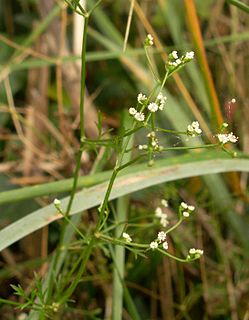
Petroselinum (parsley) is a genus of two species of flowering plants in the family Apiaceae, native to western and southern Europe and northern Africa. They are bright green hairless biennial herbaceous plants, rarely annual plants. In the first year, they form a rosette of pinnate to tripinnate leaves and a tap root used as a food store over the winter. In the second year they grow a flowering stem up to 1 m tall with sparser leaves and umbels of white or pinkish to yellowish-green flowers.

Euphorbia esula, commonly known as green spurge or leafy spurge, is a species of spurge native to central and southern Europe, and eastward through most of Asia north of the Himalaya to Korea and eastern Siberia.

Dasiphora fruticosa is a species of hardy deciduous flowering shrub in the family Rosaceae, native to the cool temperate and subarctic regions of the northern hemisphere, often growing at high altitudes in mountains. Dasiphora fruticosa is still widely referenced in the horticultural literature under its synonym Potentilla fruticosa. Common names include shrubby cinquefoil, golden hardhack, bush cinquefoil, shrubby five-finger, widdy, and kuril tea.
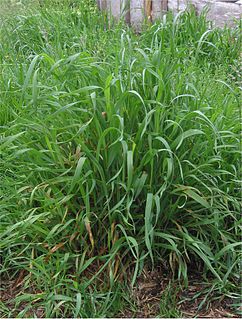
Elymus repens, commonly known as couch grass, is a very common perennial species of grass native to most of Europe, Asia, the Arctic biome, and northwest Africa. It has been brought into other mild northern climates for forage or erosion control, but is often considered a weed.

Dianthus armeria, the Deptford pink or grass pink, is a species of Dianthus ("pink") native to most of Europe, from Portugal north to southern Scotland and southern Finland, and east to Ukraine and the Caucasus. It is naturalised in North America.

Armeria maritima, the thrift, sea thrift or sea pink, is a species of flowering plant in the family Plumbaginaceae. It is a compact evergreen perennial which grows in low clumps and sends up long stems that support globes of bright pink flowers. In some cases purple, white or red flowers also occur. It is a popular garden flower and has been distributed worldwide as a garden and cut flower. It does well in gardens designed as xeriscapes or rock gardens. The Latin specific epithet maritima means pertaining to the sea or coastal.
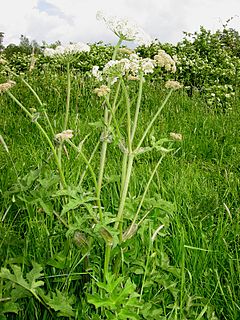
Heracleum sphondylium, commonly known as hogweed, common hogweed or cow parsnip, is a herbaceous perennial or biennial plant, in the umbelliferous family Apiaceae that includes fennel, cow parsley, ground elder and giant hogweed. It is native to Europe and Asia. The common name eltrot may also be applied, but is not specific to this species. Umbelliferous plants are so named because of the umbrella-like arrangement of flowers they produce. The North American species Heracleum maximum is sometimes included as a subspecies of H. sphondylium.

Vinca major, with the common names bigleaf periwinkle, large periwinkle, greater periwinkle and blue periwinkle, is a species of flowering plant in the family Apocynaceae, native to the western Mediterranean. Growing to 25 cm (10 in) tall and spreading indefinitely, it is an evergreen perennial, frequently used in cultivation as groundcover.
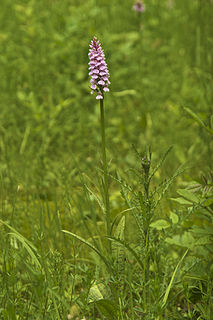
Dactylorhiza maculata, known as the heath spotted-orchid or moorland spotted orchid, is an herbaceous perennial plant of the family Orchidaceae. It is widespread in mountainous regions across much of Europe from Portugal and Iceland east to Russia. It is also found in Algeria, Morocco, and western Siberia.
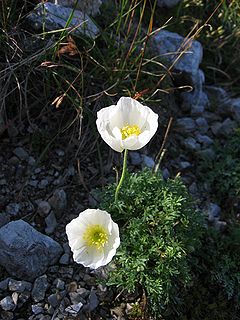
Papaver alpinum, the Alpine poppy or dwarf poppy, is a poppy found in the Alps. This species includes several sub-species, four of which are found in Austria.

Sambucus racemosa is a species of elderberry known by the common names red elderberry and red-berried elder.

Angelica lineariloba is a species of Angelica known as poison angelica or Sierra angelica. It is native to the Sierra Nevada and nearby slopes and flats in California and western Nevada from 6000 to 10,600 ft in elevation. This is a taprooted perennial herb producing an erect, hollow stem up to about 1.5 meters tall. The large but feathery leaves are made up of many highly dissected leaflets which are linear to threadlike in shape. The inflorescence is a compound umbel with up to 40 rays holding clusters of small white to cream flowers. There are papery sheaths at the base of each petiole where it branches from the stem. The plants overall are rather similar to the other large umbellifers cow parsnip and swamp whiteheads, but cow parsnips have huge lobed but undivided leaves, while swamp whiteheads have pinnate leaves and the individual flowerheads are dense, round balls.
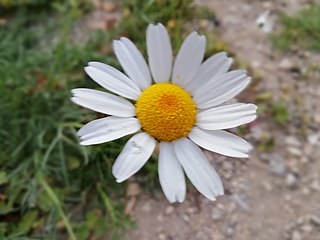
Argyranthemum frutescens, known as Paris daisy, marguerite or marguerite daisy, is a perennial plant known for its flowers. It is native to the Canary Islands. Hybrids derived from this species are widely cultivated as ornamental plants in private gardens and public parks in many countries, and have naturalized in Italy and southern California. There are many cultivars, but the most common has white petals.

Oenanthe pimpinelloides is a species of flowering plant in the family Apiaceae known by the common name corky-fruited water-dropwort or water parsley.

Rumex salicifolius is a species of flowering perennial plant in the knotweed family known by the common names willow dock and willow-leaved dock. It is native to much of western North America, and more specifically, in southern and central parts of California, and some parts of Arizona and Nevada. It can also be found in parts of Europe as an introduced species and a roadside weed. It is an extremely variable plant which is generally divided into many varieties, some of which may actually be specimens of other species.

Pimpinella major, common name greater burnet-saxifrage or hollowstem burnet saxifrage, is a herbaceous perennial plant in the genus Pimpinella belonging to the carrot family (Apiaceae).

Rhamnus alaternus is a species of flowering plant in the buckthorn family Rhamnaceae, known by the common names Italian buckthorn or Mediterranean buckthorn. It is a hardy medium-sized evergreen shrub with fragrant flowers.
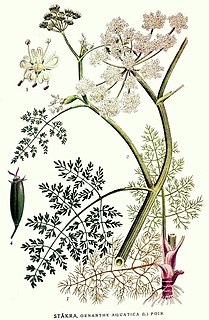
Oenanthe aquatica, fine-leaved water-dropwort is an aquatic flowering plant in the carrot family. It is widely distributed from the Atlantic coast of Europe to central Asia.
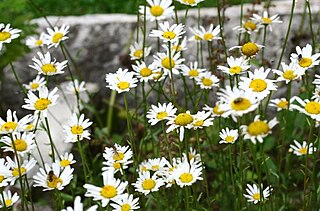
Leucanthemum ircutianum is a herbaceous perennial plant species in the family Asteraceae, that can be found growing in Eurasian countries and North America. Just like the similar L. vulgare, it is commonly known as the oxeye daisy.




















